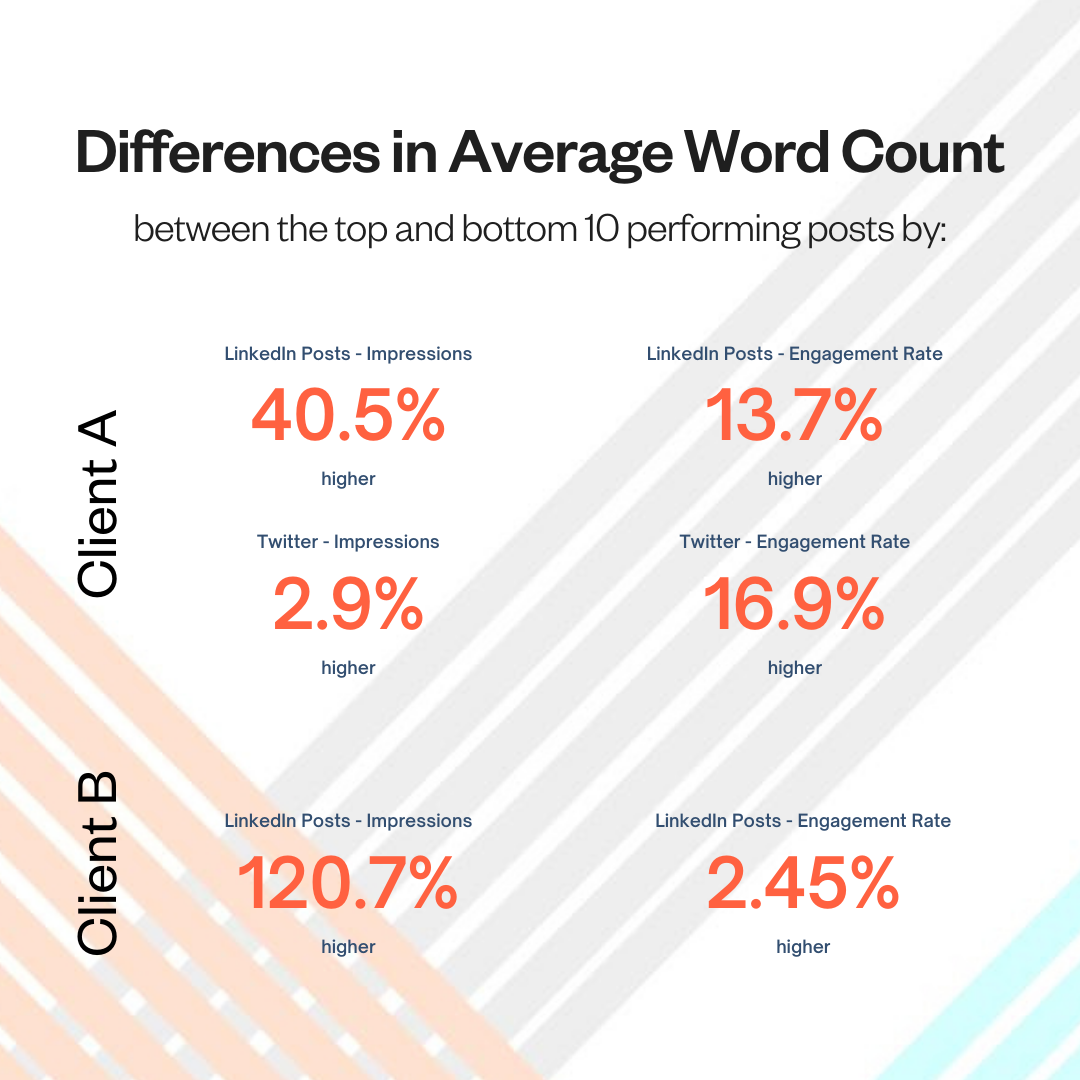The long and short of it: Is shorter really better in B2B social?

When you’re scrolling through social media, what catches your attention?
As social media users, we don’t stop to think about it in great detail. We swipe, sometimes stop, press like on what we like – and move on. But rarely do we consider what made us stop scrolling in the first place.
When it comes to what works on social media, us marketers are a bit more sure of ourselves. As the received wisdom goes: Your audience is inundated with content, posts and puns every second of the day. If you want to stand out in this forum of ultra-low attention spans, you’d better make sure your content is short and eye-catching.
But I work in marketing ops; my job is to rely on data, not received wisdom. And there’s nothing I love more than unveiling an oft-quoted best practice and seeing how true it really is. So, I was curious to discover a little more about the data sitting behind this marketer’s mantra of the pithy social media post. Here’s what I discovered.
Short and long on social media
Traditionally, social media has been heavily visually focused, with images and videos being the main attraction and captions being mostly there for context.
But as social media has grown, it’s entered a new era of content creation. Now, content and ideas are often generated, shared and evolved entirely on social media – rather than simply being accessed through it. What worked in the early days of social media has had to adapt.
So here’s my thesis: Against that backdrop, is it possible that longer posts might be more popular today than they were in the early days of social media? If you look at the development of social media platforms in recent years, it’s certainly plausible:
Twitter:
- In 2017, Twitter doubled its character limit from 140 to 280.
- Threading has emerged as a popular way of linking multiple tweets together to tell a more complex story.
LinkedIn:
- In 2015, the news aggregation service Pulse was integrated into LinkedIn, letting users access and create authoritative news and content.
- Article creation was extended in 2021 to businesses as well as individuals with articles for pages, allowing organisations to publish blog-style content of any length.
Also last year, LinkedIn more than doubled its character limit for posts, going from 1,300 to 3,000.
So, all of this got me thinking. It’s clear that social media has changed over the last decade. The platforms themselves are aware of this trend – and are tripping over themselves to accommodate longer and more authoritative content. So why haven’t our marketers best practices evolved with them? Why are we still assuming shorter is always better? And is it time to entirely rewrite the rules of what does and doesn’t fly on social media?
Ok, ok, so entirely rewrite might be a little ambitious. But my interest was certainly piqued enough to dig a little deeper. So I decided to do some of my own investigating.
What I discovered about social media
I suspect that in the last few years, longer posts have started to get a lot more attention across social media platforms. If that wasn’t the case, why would the social media platforms be so desperate to accommodate them? But ultimately, we’re still swimming in the world of hearsay. What I needed were some hard facts to back up my theory.
Luckily, as a marketing ops specialist, I spend a lot of time running the numbers on what does and doesn’t work in my clients’ social strategies. So, I thought I’d dig into one clients’ LinkedIn and Twitter posts over the last 12 months. Here’s what I found:
- The 10 posts that had the most impressions were on average 13.3 words longer than the 10 that had the fewest impressions.
- The 10 posts that had the most engagement were on average 4.6 words longer than the 10 that had the least engagement.
- The 10 tweets that had the most impressions were on average 0.9 words longer than the 10 that had the fewest impressions.
- The 10 tweets that had the most engagement were on average 5.3 words longer than the 10 that had the least engagement.
Just to check it wasn’t a fluke, I thought I’d take a look at one more client. Looking at LinkedIn posts scheduled over the last 6 months, I discovered:
- The 10 posts that had the most impressions were on average 65 words longer than the 10 that had the fewest impressions.
- The 10 posts that had the most engagement were on average 1.9 words longer than the 10 that had the least engagement.

The data shows that longer captions have outperformed shorter ones on both LinkedIn and Twitter, by every metric. By engagement, the difference was fairly small on both counts. But perhaps most interestingly, by impressions, the difference is significant. So, why might that be? Well, I have some theories.
Why do longer social captions perform better?
There’s no one clear reason why longer captions on social media can perform better. But there are a couple of pretty promising explanations. Here’s a few:
1. Social media platforms act like search engine
2. Longer posts = more information
3. Build a connection with your audience.
So after all this data, what have we learned? How long should your posts be? Here’s my advice:
1. See what’s currently performing well
2. Experiment with long-form captions
So, to answer our original question – is shorter always better? Clearly not. It certainly can be and might well be for you. But it depends on your audience, what they prefer and how informative your social content is.
Remember that the story you’re telling on social media is just as important as the images and videos you share – it provides context, adds personality, and can inspire your followers to take action.
Ultimately, like with any piece of content – the fundamentals of engaging your audience remain the same whether your posts are tiny or titanic: Create valuable content, don’t waste people’s time, and find the human element in everything you do. Ultimately, good content is good content however long it is.
